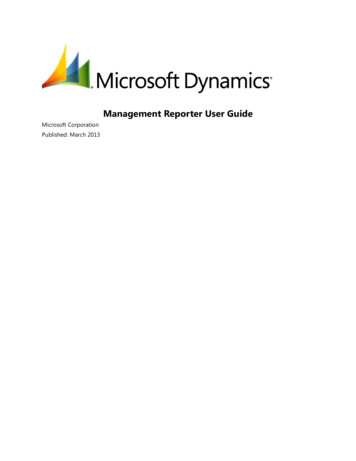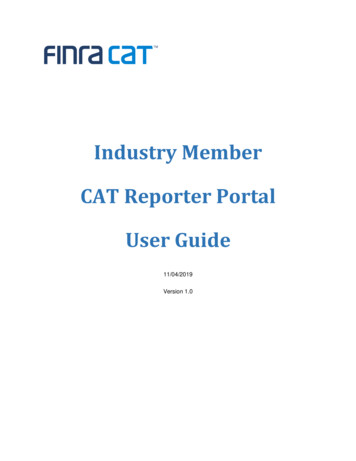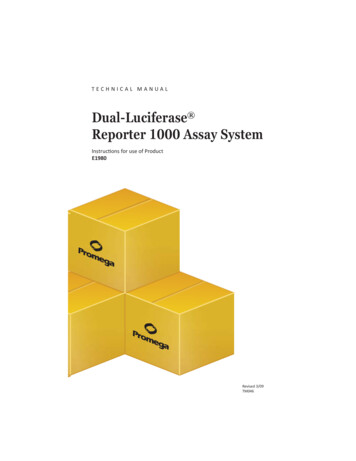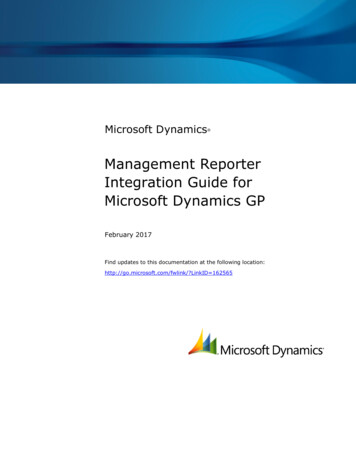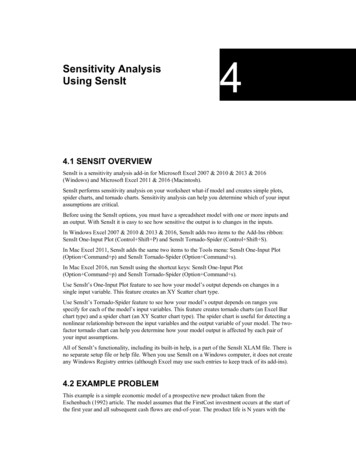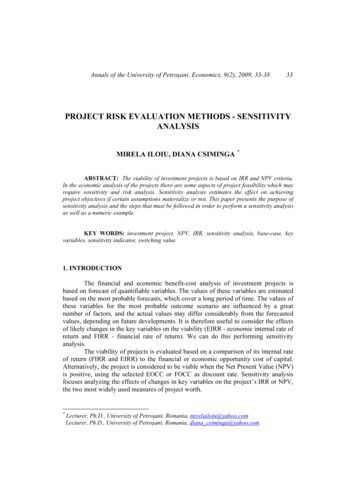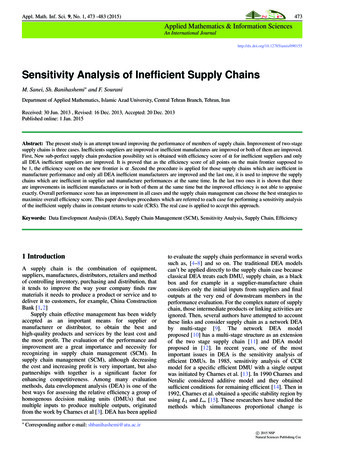
Transcription
REOR SONLYSERCH UEAFUltra-High SensitivityLuminescence Reporter Gene Assay System
britelite plus Opmaak 1 22-04-15 14:12 Pagina 1FOR IN VITRO RESEARCH USE ONLYContentsPage1. Introduction32. britelite plus description43. Contents and storage of britelite plus114. Additional requirements135. Assay procedure136. Stability of britelite plus reagent157. Recommendations for use168. Ordering Information189. References19
britelite plus Opmaak 1 22-04-15 14:12 Pagina 22
britelite plus Opmaak 1 22-04-15 14:12 Pagina 31. IntroductionLuciferase from the North American firefly (Photinuspyralis) is one of the most frequently used enzymes forreporter gene assays. Firefly luciferase catalyzes theoxidation of the firefly-specific substrate D-luciferin toproduce light. This reaction is extremely efficient andthe quantum yield is the highest of any characterizedbioluminescent reaction. The bright light produced fromthe reaction makes firefly luciferase a valuable enzyme forreporting promoter activity.1,2Light emission results from multi-step reactions. The initialreversible reaction step is the activation of D-luciferinin the presence of ATP, Mg2 and luciferase enzymewhich leads to enzyme bound adenyl-luciferin with theelimination of inorganic pyrophosphate (PPi).Subsequent reaction steps involve the oxidation of adenylluciferin with molecular oxygen via adenyl-oxyluciferinto yield AMP, CO2 and oxyluciferin. The oxyluciferin isgenerated in an electronically excited state which emitslight upon transition to the ground state. The overallreaction is shown in Figure 1.When light emission is initiated by the addition ofluciferase to a reaction mixture containing ATP, Mg2 andD-luciferin in the presence of oxygen, a fast increase inlight intensity can be seen followed by a rapid decrease to3
britelite plus Opmaak 1 22-04-15 14:12 Pagina 4HOSNCOOHLuciferase ATP O 2NMg 2S D-LuciferinHOSNNSO PPi AMP CO 2 LightOxyluciferinFigure 1: Reaction schemea low level of sustained light (flash-type kinetics). Theseflash-type kinetics have been thought to be the result ofthe formation of intermediate product (adenyl-oxyluciferin)at the enzyme surface which inhibits the enzyme.4Several substances have been described that stimulatethe light production by promoting the release of theinhibitor from the enzyme.3,4 The enhancement in enzymeturnover yields an increase in light output.The PerkinElmer britelite plus assay system is a proprietaryformulation that modifies the enzymatic reaction to producea longer lasting light output at high signal intensity.2. britelite plus descriptionbritelite plus is a homogeneous long-lived glow type high4
britelite plus Opmaak 1 22-04-15 14:12 Pagina 5sensitivity firefly luciferase reporter gene assay system forthe quantification of firefly luciferase expression inmammalian cells. The reagent formulation containscompounds that facilitate both cell lysis as well as theluciferase enzymatic reaction. britelite plus is especiallysuitable for continuous process systems using microplatesin ultra-high throughput environments. These in-linesystems do not require a very long signal half-life sincethe time between addition of the reagent and readingthe resulting luminescence is relatively short (minutes).In general, britelite plus has a signal half-life ofapproximately 30 minutes. This relative short half-life hasfacilitated the design of this luciferase assay system with avery high light output. britelite plus does not contain thiolcompounds like dithiothreitol (DTT) and is therefore odorfree.britelite plus offers the following benefits: Very high assay sensitivityDesigned for continuous process systemsSuitable for higher density microplates such as384-well and 1536-well platesIdeal for smaller-scale sample analysis whenmaximum sensitivity is desiredOdor freeConvenient storage conditions (2 - 8 C)5
britelite plus Opmaak 1 22-04-15 14:12 Pagina 6The very high light output of britelite plus is proportional tothe firefly luciferase concentration in the sample and allowsdetection of very low levels of luciferase in microplateformats. Figure 2 shows the assay result of a dilution seriesof firefly luciferase enzyme in Dulbecco’s PBS/0.1% BSA(100 µL per well) using britelite plus in a white 96-wellOptiPlate (PerkinElmer) measured with the PerkinElmerTopCount NXT Microplate Scintillation and LuminescenceCounter. As can be seen, britelite plus allows fordetection of very low levels of luciferase (lowfemtogram range) with excellent linearity.107Counts per -1210-1110-1010-9Luciferase (gram)Figure 2: Sensitivity of britelite plusFigure 3 highlights the time course of the light output of thedescribed experiment above for 10-10 gram luciferase perwell. After britelite plus addition, an incubation time of upto 5 minutes is needed for full signal generation.6
britelite plus Opmaak 1 22-04-15 14:12 Pagina 78.0 x 106Counts per second7.0 x 1066.0 x 1065.0 x 1064.0 x 1063.0 x 1062.0 x 1061.0 x 10600102030405060Time (min)Figure 3: Time course of the luminescent signal ofbritelite plusTo assess the influence of different culture media onluminescence light output, the following experiment wasperformed using commercially available basal media inthe presence and absence of Fetal Bovine Serum (FBS)and Phenol Red (PR). 100 µL britelite plus was added to100 µL samples of the different media in a white96-well OptiPlate, where each sample containedluciferase at a concentration of 5 x 10-10 gram per mL.After shaking the plate, the light output was measuredusing a TopCount NXT. Figure 4 illustrates the results ofthe relative luminescence after 5 minutes count delay.Figure 5 shows the results of the stability of the signal asa function of the culture media used.7
britelite plus Opmaak 1 22-04-15 14:12 Pagina 8The results from Figure 4 show that the light output is tosome extent affected by FBS but that Phenol Red has amuch larger impact on the light output reflecting theconcentrations of Phenol Red in the basal media.Consequently the use of Phenol Red in culturemedia should be avoided to attain the highest signal.The stability of the luminescent signal is only somewhatdependent on the media as shown in Figure 5.100%90%Relative light output80%70%60%50%40%30%20%10%DMEMDM- P EM-PR;10% RDMEM DM FBEM S PR PR;10%MEMFBME-αSM PR α RPR;1PMR0I -1 PM %I -1 FB64S60- P 40-PRR;1PMRR0PI -1%MI -164F64 BS0 0P R;PR10%FBF1FS21 PR 2 PR;10D%DMMFB/F/F1212 S PR PR;5%FBS0%Figure 4: Relative light output in different media8
% signal remaining per 5 fe (min)100%DMEMDM-P ER M;1DMPEM D 0% RME M FB SPRM;1 PEM0% R-α ME M- FBSRPPR α M;RI-1 P 1 0 PR64 MI %-1 FB0RP- P 64SR 0MI-1 RP ; 1 - P64 M 0 % RI0 164 FBPR 0 S;1 P0% RF12F FB PR 12 S;1 PDM/F D 0% R12 MF /F1 BSPR 2 ; 5 PR%FBS% signal remaining per 5 minutesbritelite plus Opmaak 1 22-04-15 14:12 Pagina 9Figure 5: Signal stability in different media expressedas a percentage of signal remaining per 5 minutes andhalf-life (minutes)Organic solvents are often used to introduce screeningcompounds, resulting in the presence of a smallpercentage of organic solvent in the culture medium.The effect of organic solvents on the light output ofbritelite plus was investigated in the following experiment.Luciferase in culture medium (DMEM without Phenol Red,supplemented with 10% FBS) was added at 100 µL perwell to a white 96-well CulturPlate (PerkinElmer). Themedium contained various concentrations of organicsolvents (DMSO, ethanol, isopropanol and acetonitrile).Next, 100 µL of britelite plus was added to the wells. Aftershaking, the plate was sealed and the luminescence was9
britelite plus Opmaak 1 22-04-15 14:12 Pagina 10measured using TopCount NXT. The results presented inFigure 6 show that DMSO and ethanol do not affect thesignal at the indicated solvent concentrations. A decreasein signal was shown for the other solvents which wasdependent on the specific solvent concentration.The stability of the signal as shown in Figure 7 is notcompromised when using these four solvents at thetested concentrations.relative light etonitrile0%0%1%2%3%4%5%Concentration solvent (% v/v of medium)Figure 6: Relative light output in the presence of organicsolvents10
% signal remaining per 5 minutesbritelite plus Opmaak 1 22-04-15 14:12 Pagina le50%0%1%2%3%4%5%Concentration solvent (% v/v of medium)Figure 7: Signal stability in the presence of organicsolvents as a percentage of signal remaining per5 minutes3. Contents and storage of britelite plus6066766 – britelite plus 10 mL kitEach 10 mL kit contains the following components: 1 vial britelite plus Lyophilized Substrate 1 bottle britelite plus Reconstitution Buffer Manual6066761 – britelite plus 100 mL kitEach 100 mL kit contains the following components: 10 vials britelite plus Lyophilized Substrate 1 bottle of britelite plus Reconstitution Buffer Manual11
britelite plus Opmaak 1 22-04-15 14:12 Pagina 126066769 – britelite plus 1000 mL kitEach 1000 mL kit contains the following components: 4 bottles britelite plus Lyophilized Substrate 2 bottles britelite plus Reconstitution Buffer ManualNumber of data points per part number*britelite pluspart number606676660667616066769kit size10 mL100 mL1000 0,0001536-wellplate3,30033,000330,000* Based on recommended volumes per well:100 µL for 96-well, 25 µL for 384-well and 3 µL for 1536-well plateStorage conditions:britelite plus is shipped at ambient temperature and mustbe stored at 2 - 8 C upon receipt.For convenience, the britelite plus Reconstitution Buffercan be stored separately at room temperature(max. 22 C). This allows addition of the ReconstitutionBuffer to the Lyophilized Substrate without the need toequilibrate to room temperature.If stored at the recommended conditions, the kitcomponents are stable through the expiry date found onthe kit label.12
britelite plus Opmaak 1 22-04-15 14:12 Pagina 134. Additional requirementsA detection instrument such as the PerkinElmerTopCount, MicroBeta , VICTOR Light, VICTOR3 MultiLabel Reader, EnVisionTM or EnSpire is required. CCDcamera systems, such as PerkinElmer ViewLux can beused for high throughput applications.For optimum light yield, low background and minimumwell-to-well crosstalk, white microplates should be used.We recommend the use of the PerkinElmer CulturPlate,OptiPlate or ViewPlate (when visual inspection of cells ispreferred). Black plates can also be used when very highsignals are expected. Black plates will reduce well-to-wellcrosstalk but will also quench the light output.5. Assay procedure1. Equilibrate the kit components to room temperature(20 - 22 C) before reconstitution.2. For the 10 mL and the 100 mL kit reconstitute one vialof britelite plus Lyophilized Substrate with 10 mL ofbritelite plus Reconstitution Buffer.For the 1000 mL kit reconstitute one bottle of briteliteplus Lyophilized Substrate with 250 mL of britelite plusReconstitution Buffer.13
britelite plus Opmaak 1 22-04-15 14:12 Pagina 14Mix the contents of the vial gently by inversion andleave for 5 minutes. This should result in a clearhomogeneous solution.Keep the britelite plus reagent at room temperature(20 - 22 C) before use.3. Only prepare as much britelite plus reagent as neededfor one day.4. Add britelite plus reagent to each well. Equal volumesof cell culture medium and britelite plus reagent shouldbe used.For 96-well plates: add 100 µL to each well containing100 µL of cells in medium.For 384-well plates: add 25 µL to each well containing25 µL of cells in medium.For 1536-well plates: add 3 µL to each well containing3 µL of cells in medium.5. Mix the well contents (see section 7).6. Seal the plate with self-adhesive TopSeal -A.14
britelite plus Opmaak 1 22-04-15 14:12 Pagina 157. For complete cell lysis and full signal generation wait atleast 1 minute, but not longer than 15 minutes.8. Measure luminescence within 15 minutes after reagentaddition for maximum sensitivity.6. Stability of britelite plus reagentStability of reconstituted britelite plus is approximately: 85 % remaining signal after 8 hours at 20 C 95 % remaining signal after 8 hours at 4 C 90 % remaining signal after 24 hours at 4 C 80 % remaining signal after 48 hours at 4 CFreshly prepared reagents can be aliquoted and stored forone month at -20 C and for three months at -80 C.The reagents can be subjected to at least 10 freeze - thawcycles without significant loss of activity.15
britelite plus Opmaak 1 22-04-15 14:12 Pagina 167. Recommendations for use Mixing of culture medium and reagent is vital to obtainlow coefficients of variation between replicates. This isespecially important with 384- and 1536-well plates.Optimize liquid handling procedures to attain optimalreagent/medium mixing. For detailed backgroundinformation see reference 5. Phenol Red, as well as other colored compounds, willchemically not interfere with the luciferin/luciferasereaction, but will quench some of the emitted light,resulting in lower assay signals (see Figure 4).For optimal light output, the culture medium can besubstituted with Dulbecco’s PBS containingcalcium and magnesium ions prior to the addition ofbritelite plus. The luciferase reaction requires magnesium ions.Although britelite plus does contain these ions it isstrongly recommended that the sample containssufficient amount of these ions. Normal culture mediacontain these ions at sufficient levels. When handling the plates prior to measurement, workunder subdued light conditions and avoid directsunlight or bright fluorescent light. Bright light maycause plate phosphorescence resulting in higher16
britelite plus Opmaak 1 22-04-15 14:12 Pagina 17background levels. Plate phosphorescence has ahalf-life of several minutes. If more than one vial of substrate is reconstituted, it isadvised to pool all reagents before addition to theplates. Optimal room and instrument temperature is 22 C.Allow plates to adapt to room temperature afterremoval from the incubator and prior to the addition ofthe reagent. An adaptation time of 30 minutes isusually sufficient. Stacked plates will need more timeto adapt to room temperature.17
britelite plus Opmaak 1 22-04-15 14:12 Pagina 188. Ordering Informationbritelite plus10 mL britelite plus assay kit100 mL britelite plus assay kit1,000 mL britelite plus assay kitReorder No.606676660667616066769For further information on luminescence readers,microplates, seals and luminescence applications pleasecontact your local PerkinElmer representative or visit ourwebsite: http://www.perkinelmer.com18
britelite plus Opmaak 1 22-04-15 14:12 Pagina 199. References1. Alam, J. and Cook, J.L. (1990). Reporter genes:application to the study of mammalian genetranscription. Anal. Biochem. 1990 Aug 1; 188(2) 245-2542. Collin Goddard (1994). Cell based screeningapproaches: advantages of highly automated roboticstechnology in HTS.Handbook for The 1994International Forum on Advances in ScreeningTechnologies and Data Management, p.193. Wood, K.V. Recent advantages and prospects foruse of beetle luciferases as genetic reporters.In: Bioluminescence and Chemiluminescence currentstatus. Proceedings of the VIth inescence, Cambridge, September 1990.p. 543. Ed. by P. Stanley and L.J. Kricka.4. Airth, R.L., Rhodes, W.C. and McElroy, W.D. (1958).The functioning of Coenzyme A in Luminescence.Biochemica and Biophysica Acta. Vol. 27, pp. 519-5325. Hancock M.K., Medina M.N., Smith B.M. and Orth A.P.Microplate Orbital Mixing Improves High-ThroughputCell-Based Reporter Assay Readouts. J. Biomol.Screen. 2006 Nov 27. 2 2007; vol. 12: pp. 140 - 14419
britelite plus Opmaak 1 22-04-15 14:12 Pagina 20This product and/or the use of this product are coveredby PerkinElmer patent applications. By purchasing thisproduct the end user is granted a limited license to use thebritelite plus kit and reagents for researchpurposes. Purchase does not include any right to use,develop or otherwise exploit this product commercially.Limited Use LicenseU.S. Pat. 7425422 and 7951551; European Pat. 1885874and foreign equivalent patents.20Rev. C - April 2015This product is distributed and sold for life scienceresearch and commercial applications, but not fordiagnostic use. Any use of this product other than for lifescience research and commercial applications is strictlyprohibited.
PerkinElmer, Inc.940 Winter StreetWaltham, MA 02451 USAPhone: (800) 762-4000 or( 1) 203-925-4602www.perkinelmer.comEXPR00001For a complete listing of our global offices, visit www.perkinelmer.com/ContactUs.BRTLTPL-0415 / REV. E 2007-2015 PerkinElmer, Inc.
Luminescence Reporter Gene Assay System. FOR IN VITRO RESEARCH USE ONLY Contents Page 1. Introduction 3 2. britelite plus description 4 3. Contents and storage of britelite plus 11 4. Additional requirements 13 5. Assay procedure 13 6. Stability of britelite plus reagent 15 7. Recommendations for use 16 8. Ordering Information 18 9. References 19 britelite_plus_Opmaak 1 22-04-15 14:12 .

